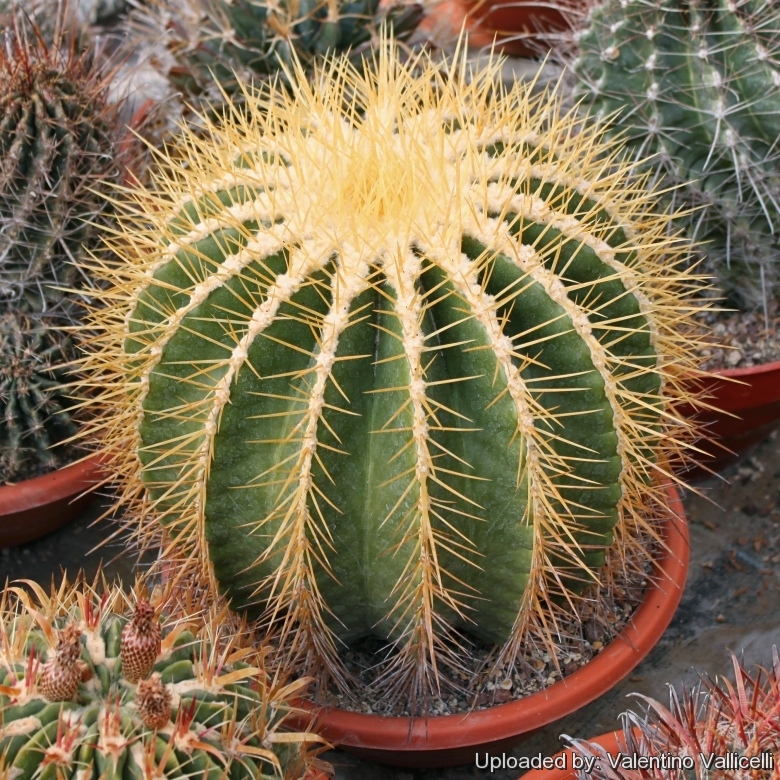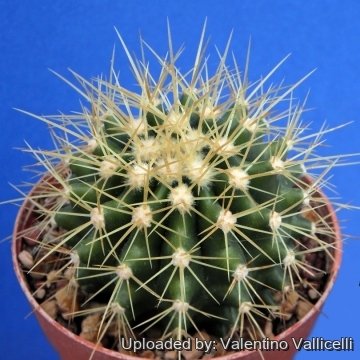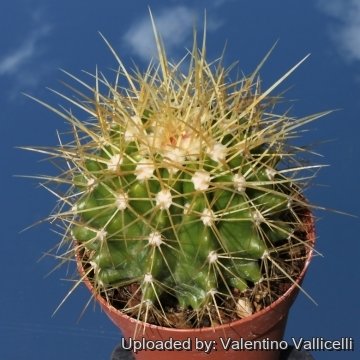
х Echinoferocactus (E. grusonii x F. schwarzii) Photo by: Valentino Vallicelli
Origin and Habitat: Garden origin (Nursery produced cultivar)
Synonyms:
See all synonyms of x Echinoferocactus (E. grusonii x F. schwarzii)
Description: This plant is an example of is a hybrid genus (or nothogenus) produced by crossing plants from two different genera (Echinocactus grusoniiSN|3345]]SN|3345]] x Ferocactus schwarziiSN|14457]]SN|14457]]) the resulting interspecific F1 hybrid shows intermediate characteristic from both the parents and straight ribs covered by yellow needle-like spines.
Subspecies, varieties, forms and cultivars of plants belonging to the Echinoferocactus group
 х Echinoferocactus (E. grusonii x F. schwarzii) Photo by: Valentino Vallicelli
х Echinoferocactus (E. grusonii x F. schwarzii) Photo by: Valentino Vallicelli х Echinoferocactus (E. grusonii x F. schwarzii) Photo by: Valentino Vallicelli
х Echinoferocactus (E. grusonii x F. schwarzii) Photo by: Valentino VallicelliCultivation and Propagation: x Echinoferocactus is a summer grower cactus that is easy to cultivate.
Growth rate: It is a relatively rapidly growing.
Soils: It likes very porous standard cactus mix soil. Prefer a low pH compost, avoid substrata rich in limestone; otherwise growth will stop altogether.
Repotting: This plant needs plenty of space for its roots, repotting should be done every other year or when the it has outgrown its pot. Use pot with good drainage.
Watering: Needs moderate to copious waterings in summer, but do not overwater (Rot prone), keep dry in winter at a minimum temperature of 5°C.
Fertilization: Feed with a high potassium fertilizer in summer.
Hardiness: Reputedly resistant to light frost if kept on the dry side prior to, and during, cold weather (hardy to -2 C ° C, or less for short periods), but for safe cultivation it is best to avoid freezing temperatures.
Exposition: The plant tolerates extremely bright situations but enjoys filtered sunlight or afternoon shade, inside it needs bright light, and some direct sun. Tends to bronze in strong light, which encourages flowering and heavy spine production, but is likely to suffer from sun scorch or stunted growth if over exposed to direct sunlight during the hottest part of the day in summer.
Uses: It is an excellent plant for container growing. It look fine in a cold greenhouse and frame or outdoor in a rockery.
Pests & diseases: It may be attractive to a variety of insects, but plants in good condition should be nearly pest-free, particularly if they are grown in a mineral potting-mix, with good exposure and ventilation. Nonetheless, there are several pests to watch for:
- Red spiders: Red spiders may be effectively rubbed up by watering the plants from above.
- Mealy bugs: Mealy bugs occasionally develop aerial into the new growth among the wool with disfiguring results, but the worst types develop underground on the roots and are invisible except by their effects.
- Scales: Scales are rarely a problem.
- Rot: This species is particularly easy and accommodating, seldom suffer of cryptogamic diseases. Rot it is only a minor problem with cacti if the plants are watered and “aired” correctly. If they are not, fungicides won't help all that much.
Propagation: Direct sow after last frost. Seeds germinate in 7-14 days at 21-27° C in spring, remove gradually the glass cover as soon the plants will be well rooted (ca 1-2 weeks) and keep ventilated, no full sun for young plants!













